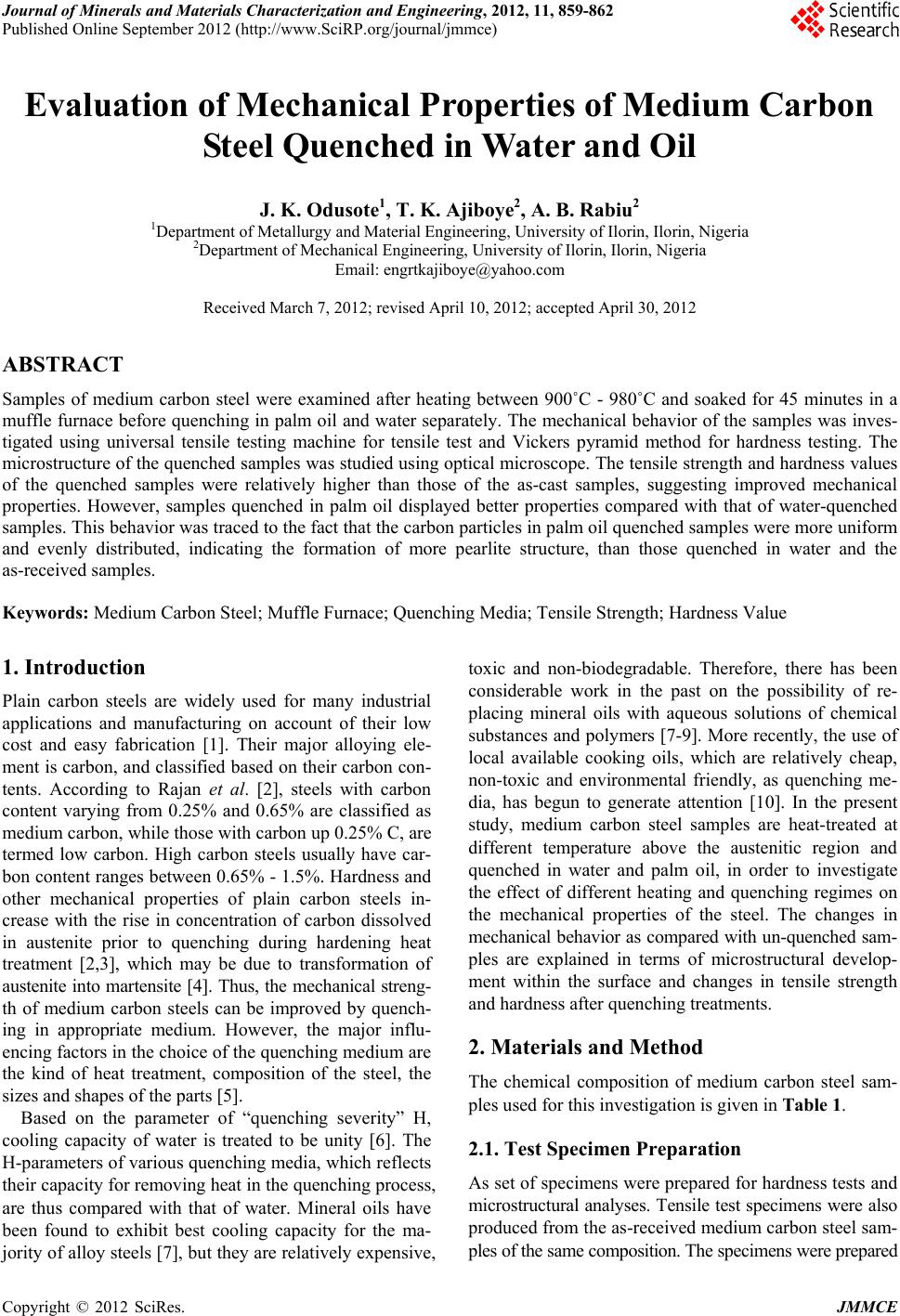
Journal of Minerals and Materials Characterization and Engineering, 2012, 11, 859-862
Published Online September 2012 (http://www.SciRP.org/journal/jmmce)
Evaluation of Mechanical Properties of Medium Carbon
Steel Quenched in Water and Oil
J. K. Odusote1, T. K. Ajiboye2, A. B. Rabiu2
1Department of Metallurgy and Material Engineering, University of Ilorin, Ilorin, Nigeria
2Department of Mechanical Engineering, University of Ilorin, Ilorin, Nigeria
Email: engrtkajiboye@yahoo.com
Received March 7, 2012; revised April 10, 2012; accepted April 30, 2012
ABSTRACT
Samples of medium carbon steel were examined after heating between 900˚C - 980˚C and soaked for 45 minutes in a
muffle furnace before quenching in palm oil and water separately. The mechanical behavior of the samples was inves-
tigated using universal tensile testing machine for tensile test and Vickers pyramid method for hardness testing. The
microstructure of the quenched samples was studied using optical microscope. The tensile strength and hardness values
of the quenched samples were relatively higher than those of the as-cast samples, suggesting improved mechanical
properties. However, samples quenched in palm oil displayed better properties compared with that of water-quenched
samples. This behavior was traced to the fact that the carbon particles in palm oil quenched samples were more uniform
and evenly distributed, indicating the formation of more pearlite structure, than those quenched in water and the
as-received samples.
Keywords: Medium Carbon Steel; Muffle Furnace; Quenching Media; Tensile Strength; Hardness Value
1. Introduction
Plain carbon steels are widely used for many industrial
applications and manufacturing on account of their low
cost and easy fabrication [1]. Their major alloying ele-
ment is carbon, and classified based on their carb on con-
tents. According to Rajan et al. [2], steels with carbon
content varying from 0.25% and 0.65% are classified as
medium carbon, while those with carbon up 0.25% C, are
termed low carbon. High carbon steels usually have car-
bon content ranges between 0.65% - 1.5%. Hardness and
other mechanical properties of plain carbon steels in-
crease with the rise in concentration of carbon dissolved
in austenite prior to quenching during hardening heat
treatment [2,3], which may be due to transformation of
austenite into martensite [4]. Thus, the mechanical streng-
th of medium carbon steels can be improved by quench-
ing in appropriate medium. However, the major influ-
encing factors in the choice of the quenching medium are
the kind of heat treatment, composition of the steel, the
sizes and shapes of the parts [5].
Based on the parameter of “quenching severity” H,
cooling capacity of water is treated to be unity [6]. The
H-parameters of various quenching media, which reflects
their capacity for removing heat in the quenching process,
are thus compared with that of water. Mineral oils have
been found to exhibit best cooling capacity for the ma-
jority of alloy steels [7], but they are relatively expens ive,
toxic and non-biodegradable. Therefore, there has been
considerable work in the past on the possibility of re-
placing mineral oils with aqueous solutions of chemical
substances and polymers [7-9]. More recen tly, the use of
local available cooking oils, which are relatively cheap,
non-toxic and environmental friendly, as quenching me-
dia, has begun to generate attention [10]. In the present
study, medium carbon steel samples are heat-treated at
different temperature above the austenitic region and
quenched in water and palm oil, in order to investigate
the effect of different heating and quenching regimes on
the mechanical properties of the steel. The changes in
mechanical behavior as compared with un-quenched sam-
ples are explained in terms of microstructural develop-
ment within the surface and changes in tensile strength
and hardness after quenching treatments.
2. Materials and Method
The chemical composition of medium carbon steel sam-
ples used for this investig ation is given in Table 1.
2.1. Test Specimen Preparation
As set of specimens were prepared for hardness tests and
microstructural analyses. Tensile test specimens were also
produced from the as-received medium carbon steel sam-
ples of the same composition. The specimens were prepared
Copyright © 2012 SciRes. JMMCE